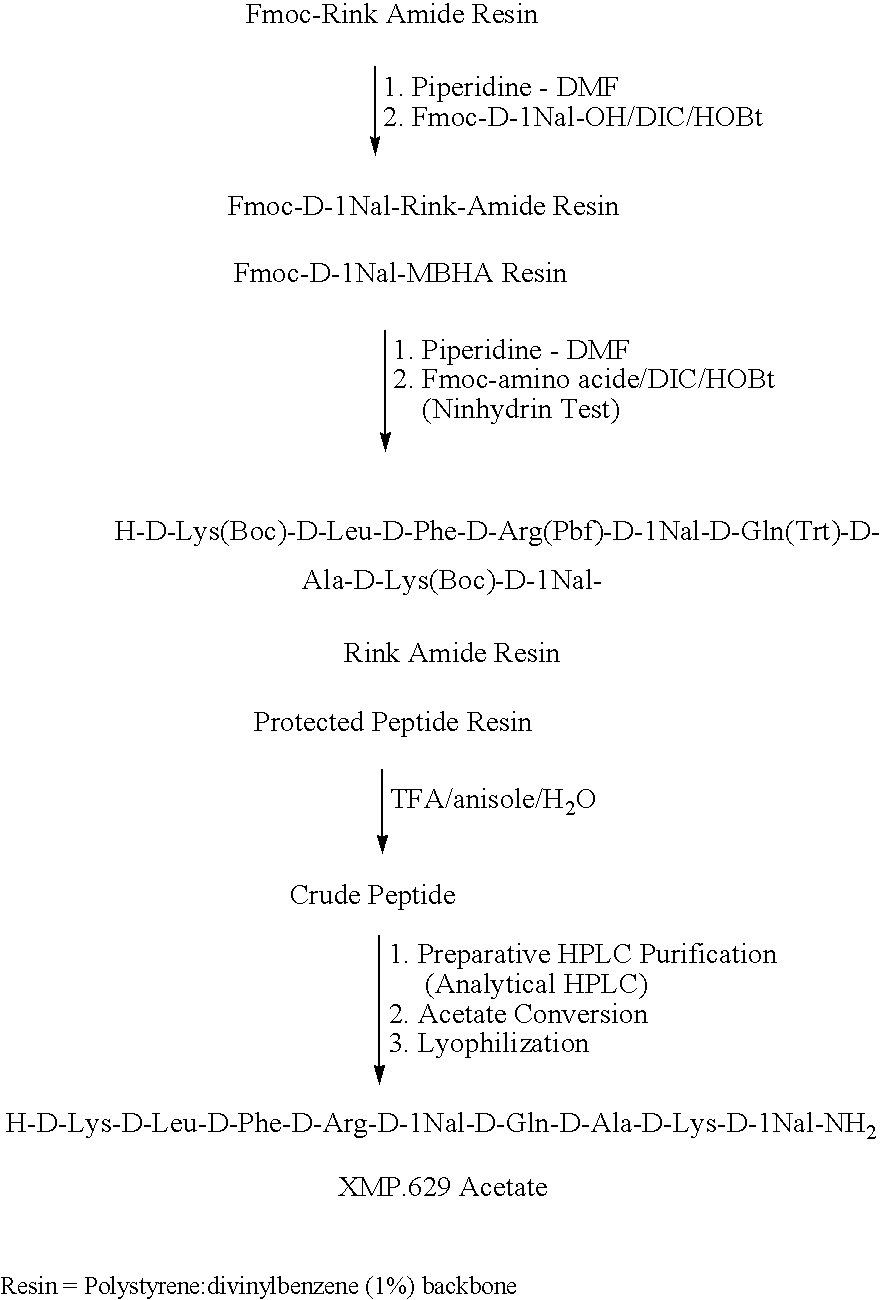Methods and materials including for treating acne
- Summary
- Abstract
- Description
- Claims
- Application Information
AI Technical Summary
Benefits of technology
Problems solved by technology
Method used
Image
Examples
example 1
Preparation and Characterization Studies
[0079] This example addresses the preparation and characterization of XMP.629. XMP.629 as well as salts and derivatives of XMP.629 can be prepared by a variety of synthetic procedures, including as described and referenced in U.S. Pat. No. 6,515,104. As described herein, XMP.629 was synthesized using a modified solid-phase procedure first described by Merrifield (Merrifield, R. B., Science, Vol. 150, p. 178-185, 1965). The α-amino group of each D-amino acid was protected with a t-butyloxycarbonyl (Boc) group. The sidechain functional groups were protected as follows: lysine was protected as a 2-chlorobenzyloxycarbonyl derivative, arginine was protected as a tosyl derivative, and glutamine was protected as a xanthyl derivative.
[0080] The peptide chain was assembled by first coupling the C-terminal amino acid, Boc-D-1-Naph (Boc-D-1 NaI—OH), to a 4-methylbenzhydrylamine (MBHA) resin support (Matsueda and Stewart, Peptides 2, p. 45-50, 1981). Th...
example 2
Antimicrobial Activity Studies
[0090] This example addresses studies relating to the antimicrobial activities of XMP.629. An in vitro assessment of antibiotic activity in XMP.629 and various known antibiotics against a representative panel of bacterial strains associated with acne was conducted. A broth dilution methodology was employed using guidelines established by National Committee for Clinical Laboratory Standards (NCCLS) for anaerobic organisms to establish an antibacterial profile for XMP.629. Assays to determine the minimal bactericidal concentrations (MBC) and minimal inhibitory concentration (MIC) were conducted for XMP.629 and other known antibiotics. Furthermore, test to determine post antibiotic effect (PAE) of XMP.629 were done.
[0091] Inoculum from a representative panel of bacterial strains associated with acne, such as P. acnes, P. avidum, P. granulosum, and Staphylococcus epidermis was prepared by suspending approximately 5-10 isolated bacterial colonies in pre-re...
example 3
Resistance Studies
[0111] This example addresses studies relating to resistance. The development of resistance is a known potential hazard with existing antibiotic therapies for the treatment of acne. Experiments were conducted to determine whether resistance was developed by P. acnes exposed to XMP.629.
[0112] To develop strains of P. acnes resistant to erythromycin, clindamycin and XMP.629, a P. acnes strain (ATCC 6919) was continuously passed in increasingly higher concentrations of each antibiotic. Control, naive, susceptible cultures were challenged in parallel with the treated organisms. Initially, approximately 5×106 cfu / mL of P. acnes in Brain Heart Infusion Broth (BHI) (Anaerobe Systems, Morgan Hill, Calif.). was treated with increasing concentrations of the drugs. After incubation for 48 h, the contents were plated on Brucella agar (BRU) (Anaerobe Systems, Morgan Hill, Calif.) and incubated for 72 h. Colonies from the highest drug concentration were resuspended in BHI and ...
PUM
| Property | Measurement | Unit |
|---|---|---|
| Fraction | aaaaa | aaaaa |
| Fraction | aaaaa | aaaaa |
| Fraction | aaaaa | aaaaa |
Abstract
Description
Claims
Application Information
 Login to View More
Login to View More - R&D
- Intellectual Property
- Life Sciences
- Materials
- Tech Scout
- Unparalleled Data Quality
- Higher Quality Content
- 60% Fewer Hallucinations
Browse by: Latest US Patents, China's latest patents, Technical Efficacy Thesaurus, Application Domain, Technology Topic, Popular Technical Reports.
© 2025 PatSnap. All rights reserved.Legal|Privacy policy|Modern Slavery Act Transparency Statement|Sitemap|About US| Contact US: help@patsnap.com


